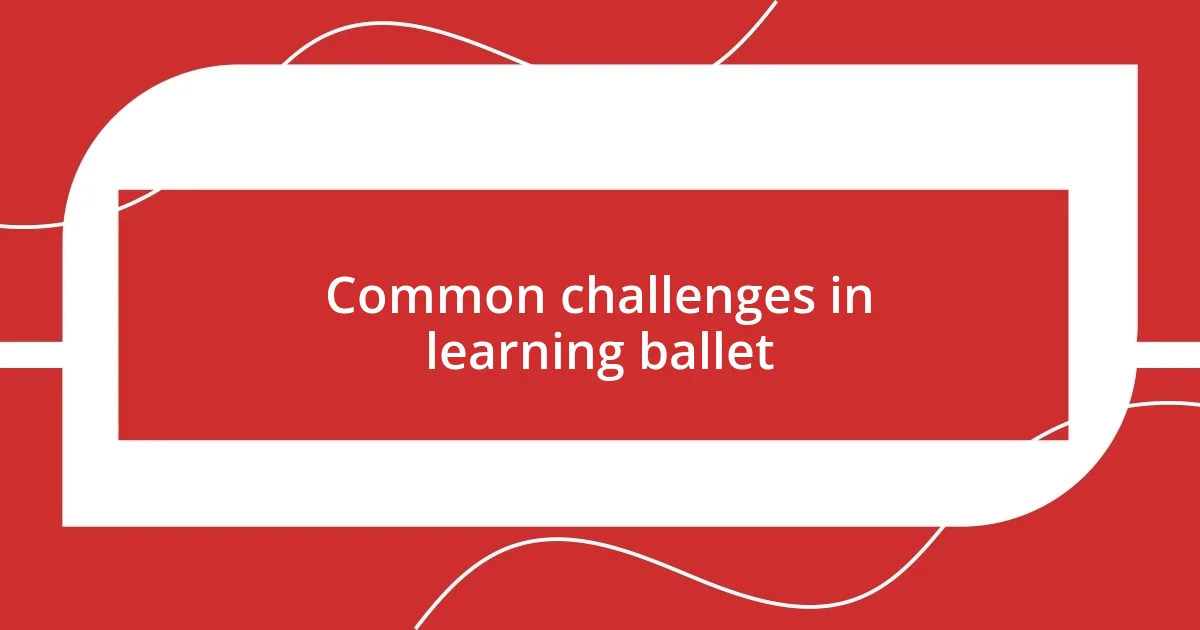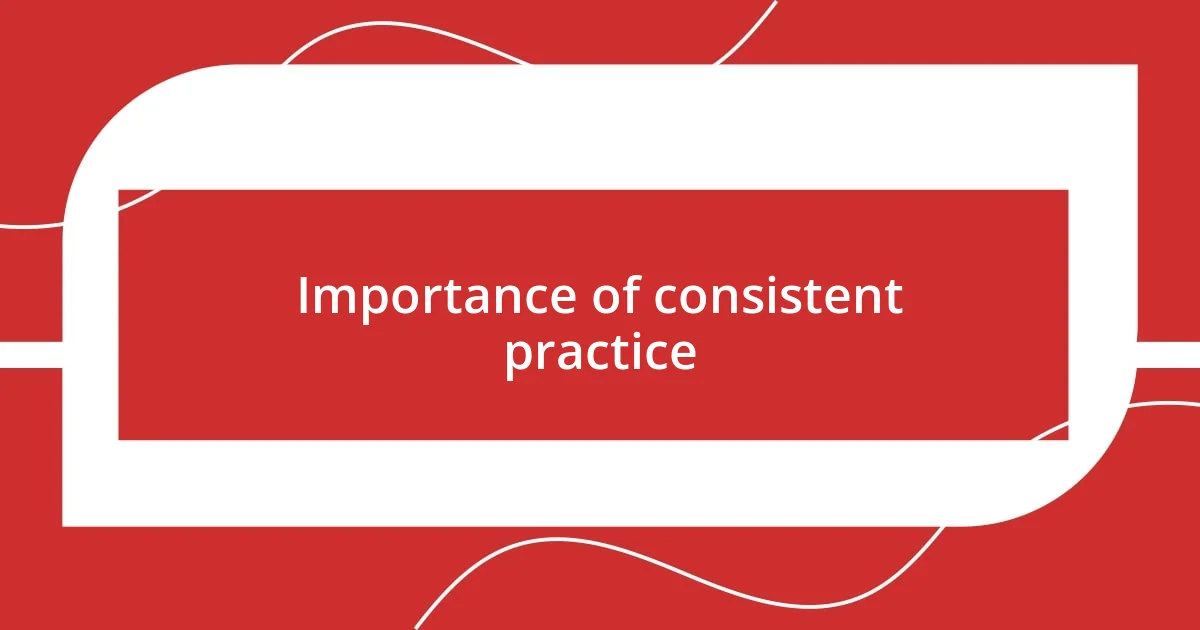Key takeaways:
- Mastering ballet techniques requires understanding foundational principles, practicing consistently, and being open to feedback and new instruction methods.
- Common challenges include the physicality of movements, technical terminology, and developing musicality; persistence and the right guidance can help overcome these hurdles.
- Celebrating small victories and sharing progress with others in the dance community enhances motivation and personal growth in ballet.

Understanding ballet techniques
Ballet techniques are the foundational skills dancers must master to express themselves through movement. I remember my first class, where the instructor emphasized the importance of posture. It struck me how a slight shift could drastically change the execution of a simple plié.
Every movement in ballet tells a story, from the precision of a tendu to the elegance of an arabesque. When I struggled with executing a clean grand jeté, I realized it wasn’t just about physical strength; it was about the mental focus required to connect my mind and body. Have you ever felt that disconnect between intention and execution?
Mastering ballet techniques involves understanding the underlying principles, such as alignment, balance, and musicality. I often find myself watching experienced dancers, captivated by their grace, and wondering how they make difficult steps look so effortless. It’s a reminder that learning these techniques is a journey, filled with moments of frustration and exhilaration alike.

Common challenges in learning ballet
Learning ballet can be a beautiful and transformative experience, but it doesn’t come without its challenges. One prominent hurdle is the physicality of the movements. I vividly recall the first time I attempted a pirouette—my balance seemed to betray me, causing me to wobble and stumble. This struggle often leaves beginners feeling frustrated, as though they’re not progressing at the pace they desire. It’s easy to get discouraged, but I learned that persistence is key.
Another common challenge lies in the technical terminology. Ballet is rich with unique terms, like “sous-sus” or “battement,” which can feel overwhelming at first. I remember feeling lost when my instructor used these words, half wondering if I had stumbled into a foreign language class instead of a dance studio. A solid understanding of these terms is essential for effective communication in class, and realizing that everyone starts from scratch can be reassuring.
Finally, developing musicality can be a real test of one’s skills as a dancer. In my early days, I struggled to find the rhythm in music while maintaining the choreography. It felt like a juggling act where I was often dropping the ball. It took me some time to understand the relationship between the music and my movements, but once that clicked, it transformed my dancing experience entirely.
| Challenge | Personal Insight |
|---|---|
| Physicality of Movements | Struggling with balance led to frustration, but persistence is key. |
| Technical Terminology | Feeling lost in unfamiliar terms created confusion but learning is a shared experience. |
| Musicality | Finding rhythm amidst choreography was initially tough, but it deeply enriches the dancing experience. |

Strategies to improve technical skills
To enhance ballet technical skills, I’ve found that consistent practice paired with targeted feedback can work wonders. For instance, there were times when I filmed my practice sessions and later watched them critically. It was eye-opening to see how minor adjustments could improve my technique significantly. If you have access to a mentor or a peer, their insights can also be invaluable, as they often spot things we overlook ourselves.
Here are some strategies that have helped me refine my skills:
- Set Specific Goals: Focus on one technique at a time, like perfecting your tendu, to avoid feeling overwhelmed.
- Utilize Cross-Training: Physically challenging your body through yoga or pilates builds strength and flexibility beneficial for ballet.
- Engage with Visual Aids: Using videos of professional dancers can inspire and clarify technique execution.
- Join Workshops or Masterclasses: These often provide unique perspectives and techniques that can enhance your understanding.
- Maintain a Dance Journal: Documenting your progress and challenges can lead to deeper insights and accountability.
I also believe that listening to my body plays a crucial role in improving my technique. If a particular movement feels off, I take a step back and assess what might be causing the issue—whether it’s lack of strength, tension, or simply misunderstanding the movement’s mechanics. Embracing this introspection has deepened my connection to dance, allowing me to develop not just my physical skills but also my mental resilience. Recognizing that improvement is a gradual journey filled with imperfections makes every small victory feel incredibly rewarding.

Importance of consistent practice
Consistent practice is the backbone of mastering ballet techniques. I remember feeling a shift in my dancing when I dedicated myself to daily rehearsals, even if it was just for thirty minutes. Each session built on the last, slowly turning chaotic movements into fluid transitions. Have you ever had that moment where repetition turned frustration into fluidity? It’s truly rewarding.
When I faced a particularly challenging step, such as developing proper turn-out, I committed to practicing it without fail. The first few tries felt clumsy; my muscles seemed to argue against me. But over time, I noticed subtle improvements—my stance became more stable and my movements more graceful. It was almost like unveiling a hidden gem within myself, and that realization kept me motivated to push through the discomfort. I often ask myself: what would I gain if I stopped now? The answer is always progress, however small.
Moreover, consistent practice had a profound impact on my mental state. I used to get discouraged after what felt like endless cycles of trying and failing. Yet, as I set aside time consistently, those moments transformed from anxiety into anticipation for what I could achieve next. I discovered that each practice session wasn’t just about the technique; it became a personal journey, weaving resilience and passion into my heart and feet. Isn’t it fascinating how our dedication shapes not only our bodies but our spirit as well?

Finding the right instruction
Finding the right instruction in ballet can be a game-changer. I once switched instructors because my progress felt stagnant, and it opened my eyes to new possibilities. My new teacher had a unique way of breaking down complex movements, making them feel much more attainable. Have you ever experienced that moment when everything suddenly clicks? It’s exhilarating!
While searching for the right guidance, I learned that compatibility is vital. One instructor’s style might resonate with you, while another’s may leave you confused. I recall attending a class where the teacher emphasized individual expression alongside technique. This approach lit a fire in me, allowing me to merge strict ballet rules with my personal flair. It made me wonder: how often do we prioritize connection over curriculum in our learning journeys?
Additionally, being open to different teaching methods has enriched my ballet experience. In one workshop, we delved into improvisation, which, surprisingly, enhanced my technique. It encouraged experimentation, allowing me to explore the freedom in each movement. How do we ensure we’re not just repeating what we know but also evolving as dancers? The answer lies in being fearless and embracing every opportunity to learn, whether it’s through a structured class or a spontaneous workshop.

Overcoming physical limitations
Facing physical limitations in ballet can feel daunting, but I’ve found that embracing these challenges is crucial for growth. I remember struggling with flexibility during my early days; while other dancers seemed to float effortlessly, I felt like a statue. It was within this discomfort that I discovered the power of targeted stretching routines. Have you ever felt defeated by your body, only to realize it was a signal for change? Focusing on specific areas allowed me to celebrate progressive milestones, transforming frustration into accomplishment.
There were moments when my body simply wouldn’t cooperate, particularly after long days of dancing. One instance stands out—I had a persistent ankle injury that made pliés excruciating. Instead of just pushing through the pain, I turned to rehabilitation exercises and gradually built strength. This experience taught me that listening to my body is just as important as pushing my limits. Have you ever wondered how a moment of listening could change everything? That’s where true resilience resides, not just in the hard work but in the smart work.
Moreover, adapting my approach to learning ballet techniques opened doors I didn’t expect. When I began incorporating strength training into my routine, I was amazed at its impact on my balance and control. I recall attending a session focused on core strength; it was nothing short of eye-opening. The mishaps I had so often dismissed suddenly became opportunities to refine my posture. Isn’t it incredible how finding new pathways to fitness can revolutionize our technique? Embracing this holistic view has made all the difference in my journey as a dancer.

Celebrating progress in ballet
Celebrating progress in ballet is about recognizing those small victories that often go unnoticed. There was a time when mastering a simple tendu felt like an insurmountable task. I still remember the thrill when I finally executed it smoothly for the first time. It felt less like a technique and more like a personal triumph, a moment that reminded me why I love this art form. Have you had similar moments where the seemingly mundane suddenly sparkles with significance?
In my journey, I also learned the importance of acknowledging growth beyond the studio walls. I recall a performance where I felt so nervous I could hardly breathe. But once I stepped on stage, something magical happened: the butterflies turned into an exhilarating rush of adrenaline. I danced with a newfound confidence, celebrating not just my technical progress but my personal evolution as well. How do we measure success in ballet? Sometimes, it’s about how we conquer our fears rather than just the steps we execute perfectly.
Interestingly, it’s often in the company of fellow dancers that progress feels amplified. Sharing my milestones with friends after class can transform a simple achievement into a celebrated event. I fondly remember the time I nailed a challenging combination, and my friends erupted in applause. Their support added another layer of joy to my success. Doesn’t it feel fantastic to have a community cheering you on? Together, we shine a brighter light on our progress in ballet, transforming individual achievements into collective celebrations.















